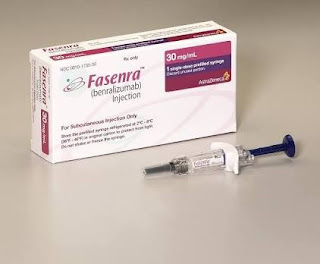The US Food and Drug Administration has approved Fasenra (benralizumab) for the add-on maintenance treatment of patients with severe asthma aged 12 years and older, and with an eosinophilic phenotype. Fasenra has a strong clinical profile which includes the ability to show lung function improvement after the first dose, the potential to reduce – or even stop – oral steroid use, and the convenience of 8-week dosing.
Fasenra also treats a distinct patient phenotype, helping physicians select the right patient in clinical practice with more confidence. Fasenra is the only respiratory biologic that provides direct, rapid and near-complete depletion of eosinophils within 24 hours, as observed in a Phase II study. Eosinophils are a type of white blood cell that are a normal part of the body’s immune system. Elevated levels of eosinophils, seen in about half of severe asthma patients, impact airway inflammation and airway hyper-responsiveness, resulting in increased asthma severity and symptoms, decreased lung function and increased risk of exacerbations.
Fasenra binds directly to the IL-5α receptor on an eosinophil and uniquely attracts natural killer cells to induce apoptosis (programmed cell death). Fasenra will be available as a subcutaneous injection via a prefilled syringe administered once every 4 weeks for the first 3 doses, and then once every 8 weeks thereafter. Fasenra is indicated for the add-on maintenance treatment of patients with severe asthma aged 12 years and older, and with an eosinophilic phenotype.
Fasenra is not indicated for treatment of other eosinophilic conditions Hypersensitivity reactions like anaphylaxis, angioedema, urticaria, rash have occurred after administration of Fasenra. These reactions generally occur within hours of administration, but in some instances have a delayed onset. Discontinue in the event of a hypersensitivity reaction. It is unknown if Fasenra will influence a patient’s response against helminth infections.
Treat patients with pre-existing helminth infections before initiating therapy with Fasenra. If patients become infected while receiving Fasenra and do not respond to anti-helminth treatment, discontinue Fasenra until infection resolves. The most common adverse reactions include headache and pharyngitis. Injection site reactions like pain, erythema, pruritus, papule occurred at a rate of 2.2% in patients treated with Fasenra compared with 1.9% in patients treated with placebo.
haleplushearty.blogspot.com


